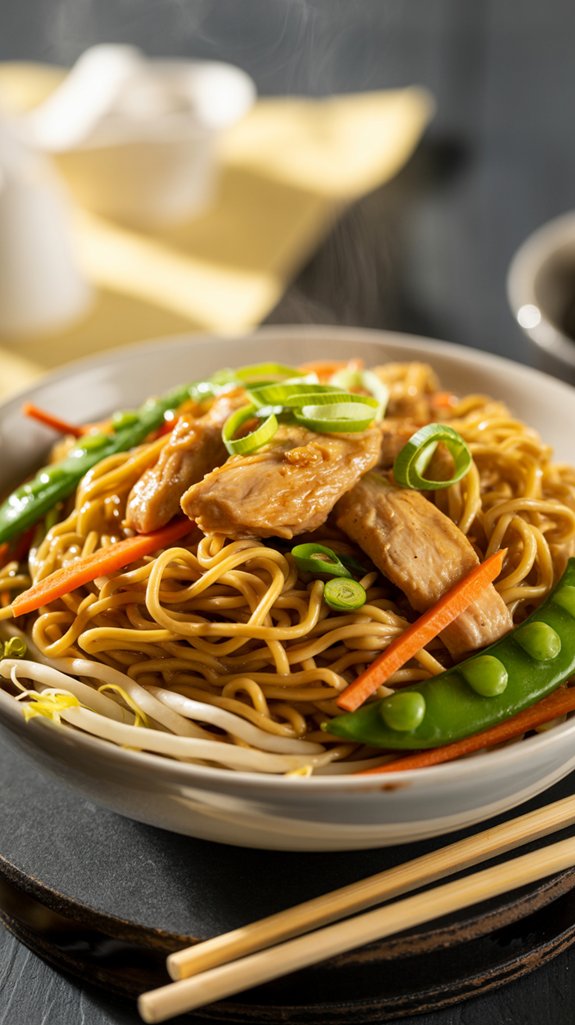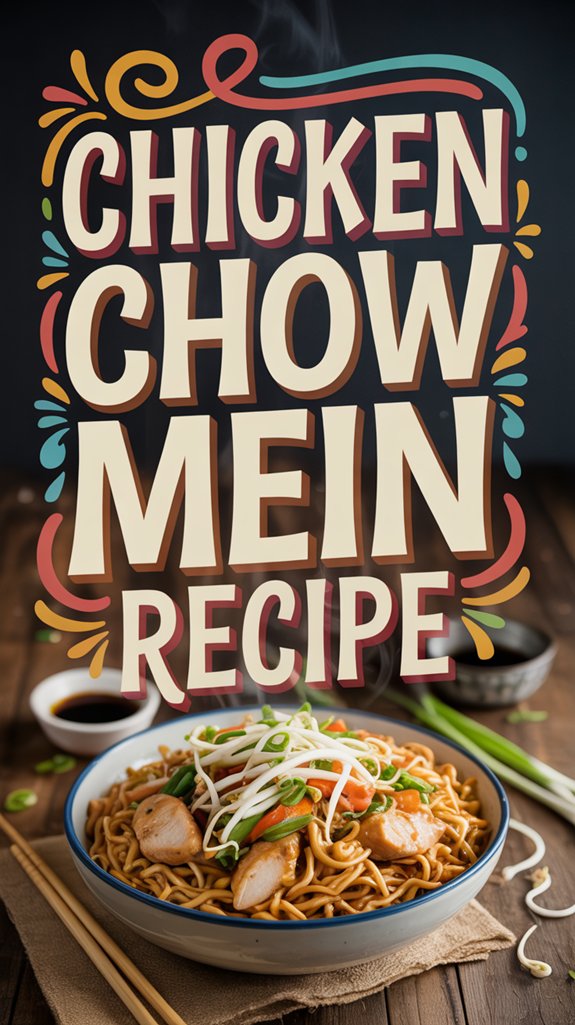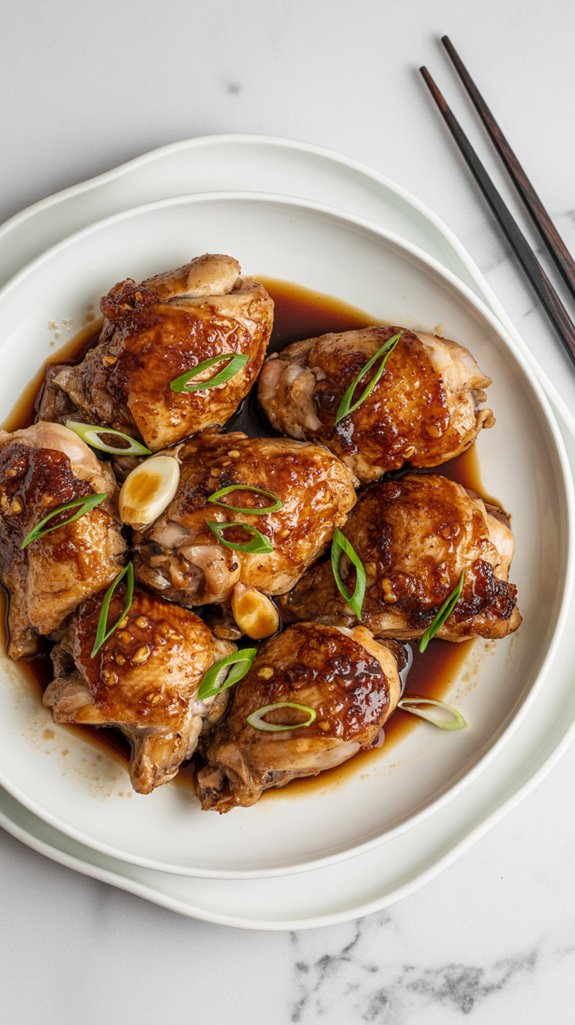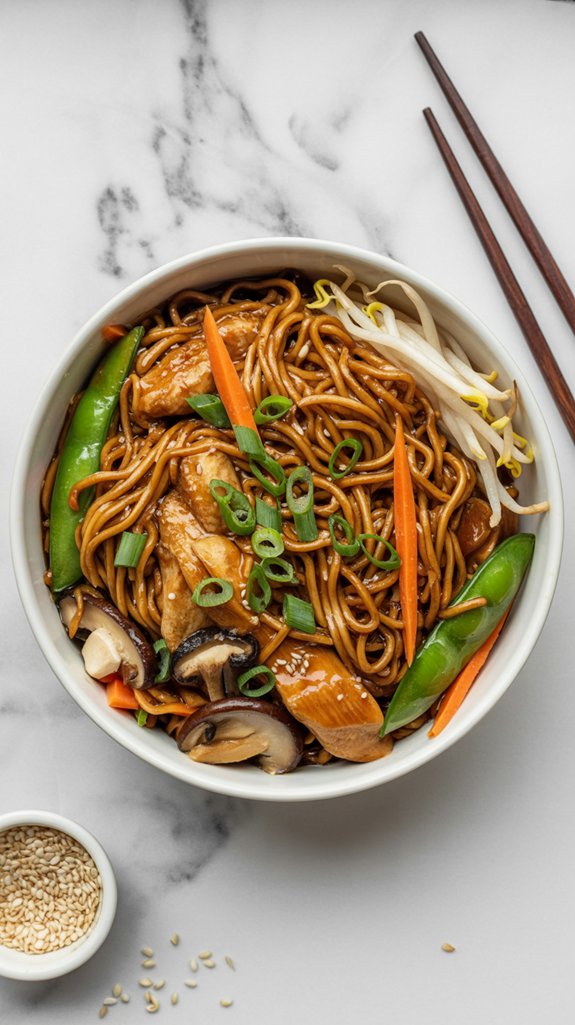Why You’ll Love This this Chinese Chicken Chow Mein
This recipe transforms simple ingredients into restaurant-quality chow mein that’ll have you wondering why you ever bothered with takeout. The quick stir-fry method keeps everything crisp and vibrant, while that cornstarch-thickened sauce brings all the flavors together in perfect harmony. Plus, you can have this gorgeous dish on the table in under 30 minutes, which means more time for eating and less time standing over the stove.
Ingredients List
This Chinese Chicken Chow Mein recipe uses fresh, simple ingredients that pack a serious flavor punch without breaking the bank.
- 2 tablespoons cornstarch
- 1 cup chicken broth
- 2 tablespoons soy sauce
- 3 tablespoons vegetable oil
- 1 lb boneless skinless chicken breasts, cut into strips across the grain
- 1 cup shredded cabbage
- 1 cup thinly sliced celery (about 2 stalks)
- 1 large onion, slivered lengthwise
- 1 (8 ounce) can sliced water chestnuts, drained
- 4 ounces sliced fresh mushrooms
- 1 garlic clove, diced fine
- 1 lb fresh bean sprouts, rinsed, drained and patted dry
Healthy Ingredient Considerations:
- The abundance of fresh vegetables makes this dish surprisingly nutritious, loaded with fiber and vitamins
- Lean chicken breast provides high-quality protein without excess fat
- The light cornstarch-based sauce keeps sodium levels reasonable compared to heavy restaurant versions
- Fresh bean sprouts and water chestnuts add satisfying crunch while keeping calories low
- Using minimal oil in the stir-fry method maintains the dish’s lighter profile
Step by Step Directions

This authentic Chinese Chicken Chow Mein comes together quickly using the traditional stir-fry method that keeps vegetables crisp and chicken tender. Having the right Indian cooking equipment can make stir-frying even more efficient for preparing dishes like this.
Step-by-Step Instructions:
- Stir together cornstarch, chicken broth and soy sauce in a small bowl to create the sauce mixture.
- Heat 2 tablespoons oil in wok or Dutch oven over high heat until very hot.
- Add chicken strips and stir-fry for 1 to 2 minutes until just cooked through.
- Transfer chicken with slotted spoon to a plate and set aside.
- Heat remaining oil in the same wok over high heat.
- Add cabbage, celery and onion, stir-frying for 1 minute until barely cooked.
- Add water chestnuts, mushrooms and garlic, continuing to stir-fry for 1 to 2 minutes.
- Add bean sprouts and stir-fry for just 30 seconds to maintain their crunch.
- Remove all vegetables to the plate with the chicken.
- Stir the prepared sauce mixture and add to wok all at once.
- Cook while stirring constantly until sauce thickens and begins to boil.
- Return chicken and vegetables to wok, tossing everything together until heated through.
- Transfer to serving bowl and serve immediately while hot.
Substitutions and Variations
- Sauce modifications – A splash of oyster sauce deepens the flavor, while a pinch of red pepper flakes adds heat for those who like things spicy.
- Noodle variation – Serve over crispy chow mein noodles instead of soft ones, or even rice if you’re going completely off-script.
- Low-sodium option – Use reduced-sodium soy sauce and chicken broth, then taste and add regular soy sauce as needed, because nobody wants to accidentally over-salt their dinner.
Additional Things to Serve With This Dish
This chow mein plays well with others, which is good news since you probably made way too much anyway.
- Fried rice – Because apparently I can never have just one type of Asian-inspired carb on my table, and honestly, who’s going to stop me.
- Egg rolls or spring rolls – Whether you go crispy-fried or fresh and light, these little wrapped bundles make perfect finger food while you’re waiting for everyone to actually sit down.
- Hot and sour soup – The tangy, warming broth cuts through all that stir-fried richness, plus it gives you something to slurp while you contemplate whether you need seconds.
- Steamed dumplings – Pork, chicken, or veggie, doesn’t matter, they’re all going to disappear faster than your willpower around leftover chow mein.
- Simple cucumber salad – Toss sliced cucumbers with rice vinegar, a touch of sugar, and some sesame seeds for something cool and crunchy that won’t compete for attention.
- Jasmine or brown rice – I know, I know, more carbs, but some people in your life might actually want plain rice alongside their saucy chicken and vegetables, and those people deserve to be fed too.
Cooking Tips & Tricks (Chef’s Notes)
Look, I’m going to save you from the mistakes that turn perfectly good chow mein into sad, soggy disappointment.
- Get everything prepped first – This dish moves fast once you start cooking, so have all your vegetables cut, your sauce mixed, and your chicken ready to go, because there’s no time for chopping onions while your garlic burns in the wok.
- Crank that heat up high – Your wok or pan needs to be screaming hot before anything goes in, hot enough that a drop of water sizzles and evaporates immediately, because lukewarm stir-frying is just steaming with extra steps.
- Don’t crowd the pan – If you dump everything in at once, you’ll end up braising instead of stir-frying, so cook in batches if you need to, even though I know you’re impatient and want it all done now.
- Keep things moving – The name literally means “stir-fry,” so use that spatula like you mean it, constantly tossing and flipping so nothing sticks or burns while other parts sit there getting mushy.
- Dry those bean sprouts completely – Pat them with paper towels or even spin them in a salad spinner, because wet vegetables create steam, and steam is the enemy of that crispy-tender texture we’re after.
- Save the sauce for last – Add it only after everything else is cooked through, then toss quickly and serve immediately, because cornstarch-thickened sauces get gummy and weird if they sit around too long.
Nutritional Facts
This hearty chicken chow mein delivers a satisfying balance of protein and vegetables while keeping calories reasonable.
Per Serving (serves 4-6):
- Calories: 280-320 per serving
- Protein: 28-35g (primarily from chicken breast)
- Carbohydrates: 18-22g (mainly from vegetables and cornstarch)
- Fat: 12-15g (from vegetable oil used in stir-frying)
- Fiber: 4-5g (from cabbage, celery, bean sprouts, and mushrooms)
- Sodium: 650-800mg (mostly from soy sauce and chicken broth)
- Vitamin C: High content from cabbage and bean sprouts
- Potassium: Good source from mushrooms and celery
- Iron: Moderate amount from chicken and vegetables
- Low in saturated fat – Most fats come from heart-healthy vegetable oil
- Gluten-containing – Traditional soy sauce contains wheat
- High water content – Fresh vegetables provide natural hydration
- No added sugars – Sweetness comes naturally from vegetables
Fun “Did You Know?”
Did you know that chow mein literally translates to “fried noodles” in Cantonese, yet this particular recipe doesn’t actually contain any noodles at all?
I find it fascinating that what we commonly call “chow mein” in American-Chinese cuisine often refers to this vegetable-heavy stir-fry dish. Traditional chow mein would include crispy or soft noodles as the base.
The dish you’re making is technically closer to “chop suey,” which means “mixed pieces.” This adaptation became popular in American Chinese restaurants because it’s lighter, more vegetable-forward, and appeals to health-conscious diners who want authentic flavors without heavy starches.





